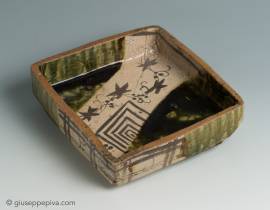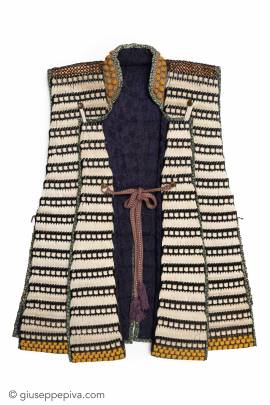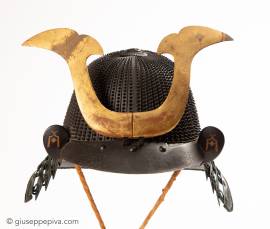Mino Ware, Oribe StyleA green glazed stoneware Oribe footed square serving dish decorated with iron wash grape leaves and geometric patternsMomoyama to Edo period, Early 17th century 20 by 18 by 5.7 cm With a tactile surface texture decorated with an asymmetrical design painted between green-glazed areas, this dish is a typical example of Green Oribe (ao-oribe) ware. The glaze fired to a vivid color flows down to the side walls pooling in rich, deep green lakes at the bottom on two opposite corners and the white strip in between is decorated in a brown iron wash with grape branches...
WORKS FOR SALE
Edo period (1615 - 1867)19th centuryIn order to emphasize their presence and dignity at military reviews or embassies, high-ranking samurai would wear on their cuirass a jinbaori, a knee-length sleeveless surcoat. In order to highlight the individuality of the samurai wearing it, the jinbaori, which first came into usage during the Momoyama period, is designed of flamboyant colors and materials. Conversely, those made using the techniques commonly employed for armor are very rare, including the one, still from the Momoyama period, preserved at the...
Koboshi kabutoSamurai helmet with standing rivetsEarly Edo Period, 17th Century A 62-plate koboshi-bachi [helmet bowl with small standing rivets] with 30 pointed rivets on each plate decreasing in size towards the top, with the exception of the larger front plate, with two lines of rivets and the small one on the back which is left blank, for a total of 1,860 rivets.The helmet is fitted with a five-plates neck protection (shikoro) of hineno style, typical of the period.The double tsunomoto riveted on the visor holds a wooden front decoration (maedate) with the classical...
Copyright © 2016 - giuseppe piva - VAT: 05104180962










